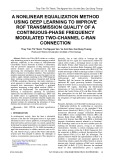
Hai-Chau Le and Chien-Trinh Nguyen
AUTOMATIC MODULATION
CLASSIFICATION FOR FLEXIBLE OFDM-
BASED OPTICAL NETWORKS
Hai-Chau Le and Chien-Trinh Nguyen
Posts and Telecommunications Institute of Technology, Hanoi, Vietnam
Abstract: Orthogonal frequency division multiplexing
(OFDM) technology, a multi-carrier digital modulation
technology, has been widely implemented in optical
networks thanks to the effective provision of dispersion
compensation for optical paths. To provide bandwidth-
abundant and flexible optical path services, OFDM-based
optical networks may need to support several modulation
formats, i.e., BPSK, QPSK, 8-PSK, and 16-QAM, and
deploy them adaptively. Recently, automatic modulation
classification (AMC) has become a promising solution for
wireless networks to identify accurately the modulation
formats of the received OFDM signals. In this paper, we
propose an effective AMC using deep learning (DL) for
flexible and adaptive OFDM-based optical networks. The
proposed DL-based AMC is able to classify four typical
modulation schemes such as binary phase-shift keying
(BPSK), quadrature PSK (QPSK), 8-PSK, and 16-
quadrature amplitude modulation (QAM) in dynamic
network conditions. Numerical experiments are performed
to verify the effectiveness of the developed solution. Our
developed solution offers significantly high accuracy,
95.83+%, even with a low SNR, says 4 dB, and its
performance is improved when the SNR is enhanced.
Keywords: Deep learning, optical network, Orthogonal
frequency-division multiplexing, modulation format,
modulation classification.
I. INTRODUCTION
Nowadays, optical transport networks have emerged as
one of the key networking technologies for next-generation
networks thanks to the capability of provisioning cost-
effective, dynamic, and heterogeneous bandwidth-
abundant flexible optical path services [1]–[4]. Orthogonal
frequency division multiplexing (OFDM) technology,
which can not only improve the spectral utilization
efficiency but also enhance transmission performance with
the deployment of adaptive high-order modulation formats
per OFDM subcarrier while efficiently dealing with fiber
dispersion compensation, has been widely adopted in next
generation optical networks [5], [6]. Next generation
optical networks have been expected to be reconfigurable,
dynamic, adaptive, spectrum grid-free, and modulation
format-free [1], [7]–[9]. Such advanced features offer a
significant enhancement of the network flexibility,
efficiency, and performance, more intelligent, effective,
and sophisticated network solutions need to be developed
[7], [10], [11]. Next-generation optical networks need to be
equipped with intelligence to interact and adapt to network
environments [5], [12], [13].
One of the key intelligent network solutions is to enable
signal receivers to identify automatically the modulated
signals, known as automatic modulation classification
(AMC) in order to realize efficient, adaptive, and flexible
optical networks in which the signal modulation and
bandwidth are determined dynamically based on the
network states [13], [14]. Parameter synchronization
between transceivers is a highly challenging task for
flexible, adaptive/ automated optical systems [9], [15],
[16]. Limitation in exchanging parameters, i.e., modulation
format and data rate, between a transmitter and a receiver
usually causes an inefficient usage of available resources.
Therefore, the receiver needs to have such an intelligent
mechanism, i.e., AMC, to detect the necessary parameters
of the transmitter to optimally make use of resources and
enhance the network performance. Automatic modulation
classification enables the receiver to identify the
modulation format of the received signal without any prior
knowledge of the transmitted signal parameters such as
symbol rate, channel state information, ... [14], [17].
Furthermore, recent advances in machine learning (ML)
including deep learning (DL) have shown a great
improvement in state-of-the-art results and led to a
widespread application in many fields especially in
communication systems. Many works introduced for deep
learning-based AMC of OFDM systems mainly focus on
wireless communication systems using OFDM [18]–[25].
Some works on DL-based AMC in optical wireless systems
have been developed [5], [16], [26]. However, to the best
of our knowledge, there is still a lack of study about deep
learning solutions for modulation classification in optical
transport networks. Different from the wireless
environment, optical transport networks using optical fiber
link has higher transmission quality but requires more
accurate modulation classification.
Contact author: Hai-Chau Le
Email: chaulh@ptit.edu.vn
Manuscript received: 29/10/2023, revised: 28/11/2023, accepted:
12/12/2023.
SOÁ 01 (CS.01) 2024
TAÏP CHÍ KHOA HOÏC COÂNG NGHEÄ THOÂNG TIN VAØ TRUYEÀN THOÂNG 18

AUTOMATIC MODULATION CLASSIFICATION FOR FLEXIBLE OFDM-BASED OPTICAL NETWORKS
In this paper, we study the automatic modulation
classification problem in flexible OFDM-based distance-
adaptive provisioning optical networks. We propose an
efficient automatic modulation classification solution that
exploits deep learning to identify accurately four typical
modulation formats including BPSK, QPSK, 8-PSK, and
16-QAM without prior knowledge about the modulated
signals or channel statistics for a flexible OFDM-based
optical network. The performance of the developed DL-
based AMC solution is estimated by using numerical
simulations. The obtained results imply that our proposed
DL-based AMC method provides a significantly high
accuracy even with a low SNR, more than 95.83% with the
SNR of 4 dB. The AMC performance is also enhanced as
the transmission quality, SNR, is better.
II. DEVELOPED AUTOMATIC MODULATION
CLASSIFICATION BASED ON DEEP LEARNING
A. OFDM-based Optical Network with Deep Learning-
based Automatic Modulation Classification
In our work, we consider an OFDM-based optical
network that employs an automatic modulation
classification with deep learning to detect the modulation
format of the received signals adaptively and automatically.
The network is assumed to adopt the distance-adaptive
modulation mechanism with four typical modulation
formats, i.e., BPSK, QPSK, 8 phase shift keying (8-PSK),
and 16-QAM, of the optical signals. For simplicity, it is
assumed that no spectrum conversion is equipped and the
optical link loss is mainly dominated by fiber loss.
User data
(bits)
OFDM
modulation
processing
Channel
Adaptation
Modulation
detection
Deep learning-based
Automatic Modulation
Classification
Preprocessing
OFDM-
based
optical
network
link
BPSK, QPSK, 8-PSK
and 16-QAM
Fig. 1. DL-based AMC scheme for flexible OFDM optical network
Figure 1 shows the system architecture of a flexible
OFDM optical network utilizing the proposed DL-based
AMC scheme. The developed deep learning-based
automatic modulation classification scheme for detecting
the modulation formats of the received signals in
noncooperative OFDM systems. User data is converted
into appropriate optical OFDM signals by OFDM
modulation and transferred through optical fiber links in the
investigated optical network. Here, note that each sub-
carrier is assumed to implement the same modulation
mode. The deep learning model will be trained by using
simulation data and is applied to recognize the modulation
formats of the received OFDM signals after preprocessing.
B. Proposed DL-based AMC Model
The proposed deep learning-based AMC model
consists of: 1) processing the input signal through sub-
networks, 2) extracting relevant features, and 3) making a
classification decision based on these features. Figure 2
illustrates our developed deep learning-based AMC
architecture. The developed model is capable of adapting
to signals with various characteristics by implementing
SubNetworks for each filter size (FFT size). It leverages
convolutional neural networks (CNNs) and fully connected
layers to learn and classify modulation schemes
automatically. In this approach, CNNs comprise a special
type of layers that use convolution operations to extract
useful representations from the input data. The automatic
modulation classification model includes three
components: (1) filter layers, (2) convolutional layers, and
(3) fully connected layers.
Fig. 2. Deep learning-based AMC architecture
❖ Input data: The input to the deep learning-based AMC
model is an OFDM signal that needs to be classified
into one of four designated modulation formats. This
signal is typically a received communication signal,
and it can be in the form of complex-valued data.
❖ SubNetworks: Deep learning model of the automatic
modulation classification employs sub-networks to
handle the signals with different characteristics. Each
sub-network is responsible for processing the input
signal with a specific filter size (FFT size) for feature
extraction. The SubNetworks include four layers as
follows.
✓ First layer: input channel number is 1, the output
channel number is 32 feature maps, kernel-size
and padding are (2, 1) and (1, 0) respectively;
✓ Second layer: number of input channels is 32, the
output is 4 feature maps, kernel size is (2, 2) and
padding is (1, 1);
✓ MaxPooling layer: window size of 2x2, stride of
2 and padding of (1x1) are used;
SOÁ 01 (CS.01) 2024
TAÏP CHÍ KHOA HOÏC COÂNG NGHEÄ THOÂNG TIN VAØ TRUYEÀN THOÂNG 19

Hai-Chau Le and Chien Trinh Nguyen
✓ Activation: LeakyReLU is implemented.
❖ Feature extraction: Each sub-network, represented by
the SubNetwork class, applies a common CNN
architecture for feature extraction. The architecture
includes convolutional layers, activation functions,
and pooling layers. The input signal is processed
through these layers to extract relevant features. The
convolutional layers learn to identify patterns and
characteristics in the signal.
❖ Filtering: After initial feature extraction using the
common CNN architecture, each sub-network applies
additional filtering to the feature representations. The
filtering is performed using a filter from the
FilterBank module, which is not provided in the code
snippet. The specific filter applied depends on the
FFT size of the sub-network.
❖ Concatenation of features: The outputs of all sub-
networks are concatenated into a single feature vector.
This feature vector contains information about the
signal's characteristics as captured by different sub-
networks.
❖ Fully connected layers: The concatenated feature
vector is passed through a sequence of fully connected
layers. These layers perform additional feature
mapping and classification. They help the model learn
and discriminate between different modulation
schemes. The final fully connected layer has a number
of output nodes equal to the number of modulation
schemes that the model aims to classify.
❖ Activation functions: After each fully connected layer,
the Tanh activation function is used. It introduces
non-linearity and helps the network capture complex
patterns in the data.
❖ Classification: The final output of the model is a
modulation classification prediction. It indicates the
most likely modulation scheme used in the input
signal. The specific modulation scheme is determined
based on the highest activation value among the
output nodes of the last fully connected layer.
In fact, the developed model is trained with simulation
data and can detect accurately four designated OFDM
modulated signals including BPSK, QPSK, 8-phase shift
keying (8-PSK), and 16-QAM, which are the most typical
in optical transport networks. Details on the dataset
generation for training and testing as well as network
parameter initialization and optimization are explained in
the next section.
III. NUMERICAL SIMULATIONS
In this section, we have simulated and evaluated the
performance of the proposed deep learning-based AMC
solution for a flexible optical OFDM network. Python
framework with PyTorch library was utilized to generate
the training and testing dataset for the simulation, build,
and train the proposed model. To evaluate the performance
of the developed DL-based AMC model, we employ major
performance metrics including Accuracy, Sensitivity
(Recall), Specificity, Precision, and F1-score. The
Accuracy estimates the total performance of the deep
learning model for classification, the Sensitivity and
Specificity consider the accuracy of diagnosis for each
modulation class, and the Precision measures the
proportion of correctly predicted positive instances. At the
same time, the F1-score is a geometric mean of
sensitivity/recall and precision, this metric provides more
meaningful results for imbalanced data sets. These
performance metrics are determined as follows.
𝐴𝑐𝑐𝑢𝑟𝑎𝑐𝑦 = 𝑇𝑃+𝑇𝑁
𝑇𝑃+𝐹𝑃+𝑇𝑁+𝐹𝑁 (1)
𝑆𝑒𝑛𝑠𝑖𝑡𝑖𝑣𝑖𝑡𝑦 = 𝑇𝑃
𝑇𝑃+𝐹𝑁 (2)
𝑆𝑝𝑒𝑐𝑖𝑓𝑖𝑐𝑖𝑡𝑦 = 𝑇𝑁
𝐹𝑃+𝑇𝑁 (3)
𝑃𝑟𝑒𝑐𝑖𝑠𝑖𝑜𝑛 = 𝑇𝑃
𝑇𝑃+𝐹𝑃 (4)
F1-score
=𝑇𝑃
𝑇𝑃+1
2(𝐹𝑃+𝐹𝑁) (5)
where TP, TN, FN, and FP respectively stand for true
positive, true negative, false negative, and false positive.
A. Dataset
In our experimental simulation, the optical network
flexibly supports distance-adaptive OFDM modulation
assignment of established optical paths. In the network,
optical paths can be modulated by one of four typical
formats that are BPSK, QPSK, 8-PSK, and 16-QAM. In
order to generate OFDM signals, user data (random bit
sequence) is modulated by applying the OFDM technique.
The modulated OFDM signals are transferred through an
optical fiber channel and the channel characteristics are
represented generally by the signal-to-ratio (SNR). For
each modulation format, data was generated for a varying
number of data subcarriers with FFT sizes of 256, 512, and
1024 and with SNR values in the range of 4 dB to 16 dB in
steps of 4 dB. Moreover, each modulation format consists
of 1000 examples for each of the subcarrier and SNR
values. The data is split into 85% for training and 15% for
validation. Here, note that each sub-carrier is assumed to
implement the same modulation mode. IQ samples are
generated via simulation data to train the model. Table I
summarizes major dataset parameters.
TABLE I. SIMULATION PARAMETERS
Parameter
Value
Modulation format
BPSK, QPSK, 8-PSK and 16QAM
FFT size
256, 512 and 1024
Number of symbols per
sample
2048
Number of samples
1000
Training and testing
portions
85:15
SOÁ 01 (CS.01) 2024
TAÏP CHÍ KHOA HOÏC COÂNG NGHEÄ THOÂNG TIN VAØ TRUYEÀN THOÂNG 20

AUTOMATIC MODULATION CLASSIFICATION FOR FLEXIBLE OFDM-BASED OPTICAL NETWORKS
B. Model Training
The model training is performed under the training
dataset in which SNR values are 4, 8, 12, and 16 dBs for
the epochs of 1, 5, and 10 respectively. Epoch means the
entire dataset is passed forward and backward through the
neural network only once. We applied the Adam optimizer
with initial learning rates of 10-4,10-3, 5x10-3, and 10-2 to
figure out the best hyperparameters while the batch size is
fixed at 1. Actually, the model architecture is independent
of the sample number of input signals, the model is trained
with the signal length of 2048 samples. Figures 3 and 4
describe the training loss and the overall accuracy obtained
with the epochs of 1, 5, and 10 when the applied learning
rate is 10-4. For faster convergence and higher performance,
the epoch of 5 and the learning rate of 10-4 are then selected
for the performance estimation.
Fig. 3. Training loss concerning iteration
Fig. 4. Overall accuracy versus SNR with various epoch values
C. Experimental Results
Table II summarizes the average classification
performance of the proposed AMC model in terms of
accuracy, F1-score, sensitivity, specificity, and precision
concerning the SNR. The results show that our developed
solution can achieve significant high performance with an
accuracy of more than 95.83% even at low SNR of 4 dB.
The performance metrics are improved as the SNR is
enhanced. This implies that the developed method can be
applied effectively in various network conditions.
TABLE II. OVERALL PERFORMANCE
SNR
Performance
Accuracy
F1-Score
Sensitivity
Specificity
Precision
4
0.9583
0.9580
0.9583
0.9583
0.9582
8
0.9900
0.9900
0.9900
0.9900
0.9901
12
0.9961
0.9961
0.9961
0.9961
0.9962
16
0.9989
0.9989
0.9989
0.9989
0.9989
Fig. 5. The obtained accuracy for each modulation format when the
epoch is set at 5
Fig. 6. Confusion matrix
TABLE III. PERFORMANCE OF EACH MODULATION CLASS
SNR
Modulation
Performance
Accuracy
F1-Score
Sensitivity
Specificity
Precision
4
BPSK
1.0000
1.0000
1.0000
1.0000
1.0000
QPSK
0.9784
0.9617
0.9784
0.9806
0.9456
8-PSK
0.8881
0.9121
0.8881
0.9809
0.9373
16-QAM
0.9640
0.9564
0.9640
0.9830
0.9490
8
BPSK
1.0000
1.0000
1.0000
1.0000
1.0000
QPSK
0.9809
0.9904
0.9809
1.0000
1.0000
8-PSK
0.9860
0.9792
0.9860
0.9912
0.9724
16-QAM
0.9934
0.9902
0.9934
0.9955
0.9870
12
BPSK
1.0000
1.0000
1.0000
1.0000
1.0000
QPSK
0.9977
0.9988
0.9977
1.0000
1.0000
8-PSK
1.0000
0.9922
1.0000
0.9948
0.9845
16-QAM
0.9872
0.9935
0.9872
1.0000
1.0000
16
BPSK
1.0000
1.0000
1.0000
1.0000
1.0000
QPSK
1.0000
1.0000
1.0000
1.0000
1.0000
8-PSK
0.9953
0.9976
0.9953
1.0000
1.0000
16-QAM
1.0000
0.9980
1.0000
0.9985
0.9959
SOÁ 01 (CS.01) 2024
TAÏP CHÍ KHOA HOÏC COÂNG NGHEÄ THOÂNG TIN VAØ TRUYEÀN THOÂNG 21

Hai-Chau Le and Chien Trinh Nguyen
Moreover, the classification accuracy comparison of
the developed AMC model for each modulation format is
illustrated in Figure 5 while the attained confusion
matrices are shown in Figure 6. It is verified that better
SNR offers higher classification accuracy and with the
same SNR value, the classification becomes more
effective as simpler modulation is applied. The detailed
classification performance of the developed solution is
explained in Table III. The obtained results show that the
model easily identifies BPSK modulation with the highest
performance while 8-PSK seems to be the least efficient
classification. The classification performance
enhancement even becomes better with a greater received
signal-to-noise ratio, says better transmission performance
achieved, higher reliability and accuracy are provided.
This means that the proposed method offers great
performance, especially for a high-quality transmission
environment, and is able to classify a broad range of
modulation classes including BPSK, QPSK, 8-PSK, and
16-QAM. Note that one of the limitations of the AMC
using deep learning is that the model must be retrained if
a new modulation set is deployed in the network.
IV. CONCLUSION
We have investigated modulation format classification
that exploits deep learning techniques for flexible OFDM-
based optical networks. We have proposed an efficient
deep learning-based automatic modulation classification
solution that is data-driven completely and does not need
prior knowledge about the modulated signals or channel
statistics for an OFDM-based optical network with four
typical modulation formats, i.e., BPSK, QPSK, 8-PSK, and
16-QAM. Numerical simulations have been performed to
verify the performance of the developed solution. The
obtained experimental results demonstrate that the
proposed method can be applied to automatically classify
the modulated signals effectively without any prior
knowledge of channel conditions.
REFERENCES
[1] A. Lord, P. Wright, and A. Mitra, “Core networks in the
flexgrid era,” Journal of Lightwave Technology, vol. 33, no.
5, pp. 1126–1135, 2015.
[2] S. Miladić-Tešić, G. Marković, D. Peraković, and I. Cvitić,
“A review of optical networking technologies supporting
5G communication infrastructure,” Wireless Networks, vol.
28, no. 1, pp. 459–467, 2022.
[3] X. Zeng and S. Liu, “Brief Overview of Elastic Optical
Networks-A Promising Transmission Network
Technology.”
[4] H.-C. Le, H. Hasegawa, and K. Sato, “Impact of electrical
grooming and regeneration of wavelength paths in creating
hierarchical optical path networks,” Opt Express, vol. 19,
no. 26, 2011, doi: 10.1364/OE.19.00B882.
[5] H. Mrabet, E. Giaccoumidis, and I. Dayoub, “A Survey of
Applied Machine Learning Techniques for Optical OFDM
based Networks.”
[6] X. Zhang, Z. Babar, P. Petropoulos, H. Haas, and L. Hanzo,
“The evolution of optical OFDM,” IEEE Communications
Surveys and Tutorials, vol. 23, no. 3, 2021, doi:
10.1109/COMST.2021.3065907.
[7] R. J. Essiambre, G. J. Foschini, P. J. Winzer, G. Kramer, and
B. Goebel, “Capacity Limits of Optical Fiber Networks,”
Journal of Lightwave Technology, vol. 28, no. 4, pp. 662–
701, 2010, doi: 10.1109/JLT.2009.2039464.
[8] H. C. Le and N. T. Dang, “Spectrum utilization efficiency
of elastic optical networks utilizing coarse granular
routing,” in Informatica (Slovenia), 2018. doi:
10.31449/inf.v42i3.2248.
[9] W. S. Saif, M. A. Esmail, A. M. Ragheb, T. A. Alshawi, and
S. A. Alshebeili, “Machine Learning Techniques for Optical
Performance Monitoring and Modulation Format
Identification: A Survey,” IEEE Communications Surveys
and Tutorials, vol. 22, no. 4, pp. 2839–2882, Oct. 2020, doi:
10.1109/COMST.2020.3018494.
[10] H.-C. Le, H. Hasegawa, and K.-I. Sato, “Large capacity
optical networks applying multi-stage hetero-granular
optical path routing,” Optical Switching and Networking,
vol. 11, no. PART A, 2014, doi: 10.1016/j.osn.2013.08.006.
[11] L. G. Wright, F. O. Wu, D. N. Christodoulides, and F. W.
Wise, “Physics of highly multimode nonlinear optical
systems,” Nature Physics, vol. 18, no. 9, pp. 1018–1030,
2022, doi: 10.1038/s41567-022-01691-z.
[12] Y. Sani, A. Mauthe, and C. Edwards, “Adaptive Bitrate
Selection: A Survey,” IEEE Communications Surveys and
Tutorials, vol. 19, no. 4, pp. 2985–3014, 2017, doi:
10.1109/COMST.2017.2725241.
[13] T. Huynh-The et al., “Automatic Modulation
Classification: A Deep Architecture Survey,” IEEE Access,
vol. 9, pp. 142950–142971, 2021, doi:
10.1109/ACCESS.2021.3120419.
[14] A. Kumar, K. K. Srinivas, and S. Majhi, “Automatic
Modulation Classification for Adaptive OFDM Systems
Using Convolutional Neural Networks With Residual
Learning,” IEEE Access, vol. 11, pp. 61013–61024, 2023,
doi: 10.1109/ACCESS.2023.3286939.
[15] M. Närhi, L. Salmela, J. Toivonen, C. Billet, J. M. Dudley,
and G. Genty, “Machine learning analysis of extreme events
in optical fiber modulation instability,” Nature
Communications, vol. 9, no. 1, Dec. 2018, doi:
10.1038/s41467-018-07355-y.
[16] X. Zhang, T. Van Luong, P. Petropoulos, and L. Hanzo,
“Machine-Learning-Aided Optical OFDM for Intensity
Modulated Direct Detection,” Journal of Lightwave
Technology, vol. 40, no. 8, pp. 2357–2369, 2022, doi:
10.1109/JLT.2022.3141222.
[17] S. Wang and C. Liu, “Automatic Modulation Classification
with Neural Networks via Knowledge Distillation,”
Electronics (Switzerland), vol. 11, no. 19, Oct. 2022, doi:
10.3390/electronics11193018.
[18] N. E. West and T. J. O’Shea, “Deep Architectures for
Modulation Recognition,” Mar. 2017, [Online]. Available:
http://arxiv.org/abs/1703.09197
[19] Y. Liu, Y. Liu, and C. Yang, “Modulation recognition with
graph convolutional network,” IEEE Wireless
Communications Letters, vol. 9, no. 5, 2020, doi:
10.1109/LWC.2019.2963828.
[20] R. Zhou, F. Liu, and C. W. Gravelle, “Deep Learning for
Modulation Recognition: A Survey with a Demonstration,”
IEEE Access, vol. 8. 2020. doi:
10.1109/ACCESS.2020.2986330.
[21] S. Hong, Y. Zhang, Y. Wang, H. Gu, G. Gui, and H. Sari,
“Deep Learning-Based Signal Modulation Identification in
OFDM Systems,” IEEE Access, vol. 7, pp. 114631–114638,
2019, doi: 10.1109/ACCESS.2019.2934976.
[22] Z. Huang et al., “Modulation Format Identification Based
on Signal Constellation Diagrams and Support Vector
Machine,” Photonics, vol. 9, no. 12, 2022, doi:
10.3390/photonics9120927.
SOÁ 01 (CS.01) 2024
TAÏP CHÍ KHOA HOÏC COÂNG NGHEÄ THOÂNG TIN VAØ TRUYEÀN THOÂNG 22








![Bài giảng Cáp mạng, vật tải truyền - GV. Lê Bá Thi [Chuẩn SEO]](https://cdn.tailieu.vn/images/document/thumbnail/2016/20160409/o0tchya0o/135x160/4531460212639.jpg)











![Đề thi cuối kì Nhập môn Mạng máy tính: Tổng hợp [Năm]](https://cdn.tailieu.vn/images/document/thumbnail/2025/20251110/nminhthoi53@gmail.com/135x160/38281762757217.jpg)



![Đề thi học kì 2 môn Nhập môn Mạng máy tính [kèm đáp án]](https://cdn.tailieu.vn/images/document/thumbnail/2025/20251014/lakim0906/135x160/23811760416180.jpg)

